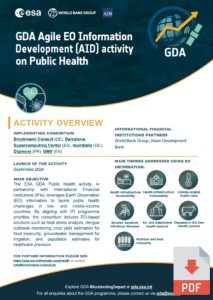ESA’s GDA Public Health case studies now online
ESA’s GDA Public Health thematic activity has just released its first set of case studies, providing a compelling overview of the ways in which satellite data is enhancing health outcomes … Read more


 Health infrastructure accessibility. Health infrastructure accessibility plays a critical role in shaping public well-being, particularly during natural disasters or crises. The central concern underscores the necessity to quantify and analyse population accessibility to health centres, emphasising the need for adequacy and responsiveness to the ever-evolving dynamics of population density and urban development. This analysis tackles the pressing issue of limited access to essential healthcare facilities, highlighting the urgent requirement for a solution capable of thoroughly assessing the sufficiency of healthcare infrastructure in alignment with population distribution.
Health infrastructure accessibility. Health infrastructure accessibility plays a critical role in shaping public well-being, particularly during natural disasters or crises. The central concern underscores the necessity to quantify and analyse population accessibility to health centres, emphasising the need for adequacy and responsiveness to the ever-evolving dynamics of population density and urban development. This analysis tackles the pressing issue of limited access to essential healthcare facilities, highlighting the urgent requirement for a solution capable of thoroughly assessing the sufficiency of healthcare infrastructure in alignment with population distribution.
 Health infrastructure vulnerability. Healthcare infrastructure is at risk from a variety of threats, both natural and human-made. Natural disasters include earthquakes, volcanic eruptions, hurricanes, floods, fires, and pandemics. Human-made disasters encompass war, pollution, nuclear and other explosions, fires, hazardous materials exposures, transportation accidents, and pandemics. These events can lead to a mass exodus of people, disease outbreaks, and destruction of property, ultimately destabilising societies.
Health infrastructure vulnerability. Healthcare infrastructure is at risk from a variety of threats, both natural and human-made. Natural disasters include earthquakes, volcanic eruptions, hurricanes, floods, fires, and pandemics. Human-made disasters encompass war, pollution, nuclear and other explosions, fires, hazardous materials exposures, transportation accidents, and pandemics. These events can lead to a mass exodus of people, disease outbreaks, and destruction of property, ultimately destabilising societies.
 Climate-related health risks.
Health is a transversal topic in climate-driven risk assessment as it assumes the negative impact of climate change in critical domains like agriculture, water, and landscape management.
Climate affects directly the spreading patterns of infectious diseases by making them more intense, persistent and broader.
Such pattern dynamics can put health resources in pressure due to lack of prevention and/or economic resources to admit and manage an increasing number of ill people and/or disease outbreaks.
Indirectly, climate affects food and water access through more severe extreme events like droughts, flooding, storms, strong wind, or sea level rise.
The result, according to new World Bank data, is that a warmer climate could lead to at least 21 million additional deaths by 2050 from just five health risks: extreme heat, stunting, diarrhoea, malaria, and dengue.
Climate-related health risks.
Health is a transversal topic in climate-driven risk assessment as it assumes the negative impact of climate change in critical domains like agriculture, water, and landscape management.
Climate affects directly the spreading patterns of infectious diseases by making them more intense, persistent and broader.
Such pattern dynamics can put health resources in pressure due to lack of prevention and/or economic resources to admit and manage an increasing number of ill people and/or disease outbreaks.
Indirectly, climate affects food and water access through more severe extreme events like droughts, flooding, storms, strong wind, or sea level rise.
The result, according to new World Bank data, is that a warmer climate could lead to at least 21 million additional deaths by 2050 from just five health risks: extreme heat, stunting, diarrhoea, malaria, and dengue.
 Environmentally sensitive infectious diseases.
Mosquito-borne diseases such as dengue, malaria and yellow fever account for a large share of the overall burden of vector-borne diseases, which place 80% of the world’s population at risk of infection and take 700,000 lives each year. They are increasing in prevalence, geographical distribution, and severity, representing an increasing threat for humans and animals worldwide. Leptospirosis is another neglected public health threat, which affects roughly 1.03 million people per year across the globe. Vulnerable populations are particularly affected, and the disease is especially prevalent in tropical and subtropical regions, with the highest burden among low- and middle-income countries. These zoonotic diseases often depend on complex interactions between vector and host species which, in turn, are influenced by changes in temperature, rainfall, land use, and other environmental factors. If these factors can be mapped in space and time, then human disease risk can be estimated.
Environmentally sensitive infectious diseases.
Mosquito-borne diseases such as dengue, malaria and yellow fever account for a large share of the overall burden of vector-borne diseases, which place 80% of the world’s population at risk of infection and take 700,000 lives each year. They are increasing in prevalence, geographical distribution, and severity, representing an increasing threat for humans and animals worldwide. Leptospirosis is another neglected public health threat, which affects roughly 1.03 million people per year across the globe. Vulnerable populations are particularly affected, and the disease is especially prevalent in tropical and subtropical regions, with the highest burden among low- and middle-income countries. These zoonotic diseases often depend on complex interactions between vector and host species which, in turn, are influenced by changes in temperature, rainfall, land use, and other environmental factors. If these factors can be mapped in space and time, then human disease risk can be estimated. Airborne and waterborne health hazards. Air pollution, wildfires, dust storms, and algae blooms are some of the health hazards that affect large populations around the world. As the frequency and severity of these events have been increasing with climate change, so has the associated health risk.
Airborne and waterborne health hazards. Air pollution, wildfires, dust storms, and algae blooms are some of the health hazards that affect large populations around the world. As the frequency and severity of these events have been increasing with climate change, so has the associated health risk.
 Emerging diseases in the One Health context. ‘One Health’ is a collaborative, multisectoral and transdisciplinary approach to balance and optimise the health of humans, animals and the environment by recognising the interconnectivity between people, flora, fauna and their shared environment. It is particularly important to prevent, predict, detect, and respond to global health threats such as the COVID-19 pandemic. The approach mobilises multiple sectors and involves the public health, veterinary and environmental sectors, making it relevant for food and water security, nutrition and the control of zoonoses (diseases that can spread between animals and humans, such as flu, rabies and Rift Valley fever).
Emerging diseases in the One Health context. ‘One Health’ is a collaborative, multisectoral and transdisciplinary approach to balance and optimise the health of humans, animals and the environment by recognising the interconnectivity between people, flora, fauna and their shared environment. It is particularly important to prevent, predict, detect, and respond to global health threats such as the COVID-19 pandemic. The approach mobilises multiple sectors and involves the public health, veterinary and environmental sectors, making it relevant for food and water security, nutrition and the control of zoonoses (diseases that can spread between animals and humans, such as flu, rabies and Rift Valley fever).
 Nutrition and food insecurity. Food security has different dimensions, namely, food availability (enough food of appropriate quality), food access (access by individuals to adequate resources for acquiring appropriate foods for a nutritious diet), utilisation (through adequate diet, clean water, sanitation and health care to reach a state of nutritional well-being where all physiological needs are met) and stability (access to adequate food at all times). Chronic and acute hunger are on the rise due to various factors, including civil conflicts, socio-economic conditions, natural hazards, climate change and pests. From the health perspective, people affected by food insecurity are more prone to experience infectious diseases, chronic conditions (heart diseases, hypertension, etc.), or mental illness.
Discover our brochure and e-flyer for more information regarding services and products provided on these themes in response to requirements identified in the water domain by IFIs and their Client Countries:
Nutrition and food insecurity. Food security has different dimensions, namely, food availability (enough food of appropriate quality), food access (access by individuals to adequate resources for acquiring appropriate foods for a nutritious diet), utilisation (through adequate diet, clean water, sanitation and health care to reach a state of nutritional well-being where all physiological needs are met) and stability (access to adequate food at all times). Chronic and acute hunger are on the rise due to various factors, including civil conflicts, socio-economic conditions, natural hazards, climate change and pests. From the health perspective, people affected by food insecurity are more prone to experience infectious diseases, chronic conditions (heart diseases, hypertension, etc.), or mental illness.
Discover our brochure and e-flyer for more information regarding services and products provided on these themes in response to requirements identified in the water domain by IFIs and their Client Countries:






